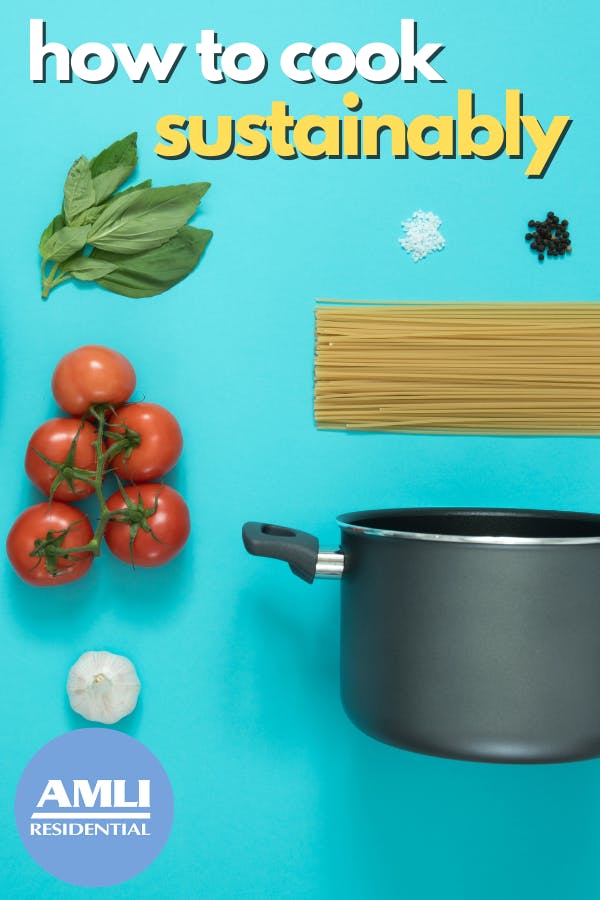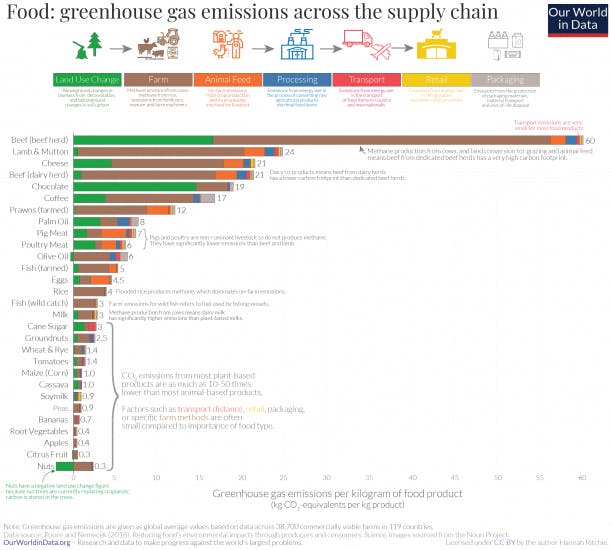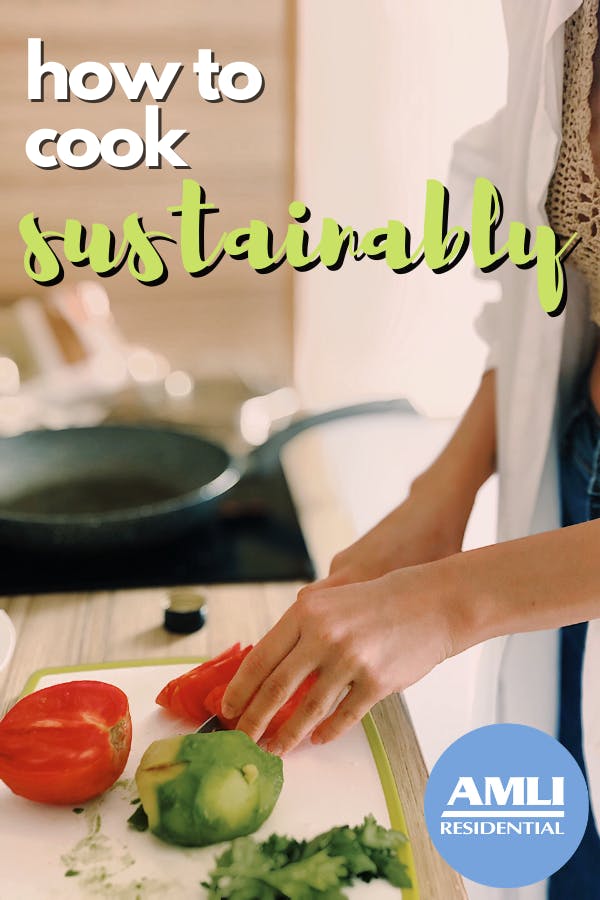Eco-friendly practices can extend into each and every facet of our lives. From living sustainably with pets to creating eco-friendly cleaning supplies, learning to live a little greener means that there’s always some part of our lifestyle that we can switch for a more environmentally-friendly one.
One area in which there is always potential for greener living is in the kitchen! What we cook, the way we cook and the tools we use to cook with all can make our environmental footprint a little smaller with just a few easy switches.
Here are a few ways you can incorporate some more eco-friendly practices into your daily food preparation and food storage habits.
Bon appetit!

Eco-Friendly cooking tips
Cook more, less often
Heating up a stove or oven takes a decent amount of energy, and maintaining that heat for extended periods of time takes quite a bit of energy, too.
For example, baking a cake or a casserole in a conventional oven might take about one hour. About 2.4 kilo-watts would be used each hour (kWh), which would equal to about $0.30.
Of course, this isn’t all about the money factor here, but when you pay for a service, then that means that you’re also paying for all the work happening behind the scenes to get you that electricity.
If you cook larger portions fewer times per week, then you minimize the amount of time the oven or stove spends heating up to the desired temperature. It’s more energy-efficient to heat up leftovers than it is to cook a brand-new meal.
You can also cut your food into smaller portions so that they cook faster and you can monitor their cook time more accurately.
Use this handy energy use calculator to find out how much energy your appliances are using!
Keep your fridge cool
In the same way that heating ovens uses plenty of energy, so does keeping a refrigerator cool. In fact, refrigerators use the most energy out of all your kitchen appliances, aside from your lights. It’s running 24 hours a day, seven days a week and it is constantly sucking electricity.
Every time the fridge door opens or a new item is placed inside, the fridge has to bring the average temperature back down to what it already was. You can’t not open the fridge, though, and it’s important to keep foods properly preserved. So what’s the solution?
First, invest in a more modern fridge that is designed to be as efficient as possible. Old fridges use far more energy than newer ones, so making that smart switch is worth the investment. Second, cool down hot food to room temperature before sticking it in the fridge. If you add hot, steaming food to the fridge, then the fridge has to work to bring the temperature back down to where it was before.
Lucky for our AMLI residents, our apartments already come equipped with ENERGY STAR-certified appliances that reduce the amount of energy used by kitchen appliances!
Keep a lid on it
Have you ever tried to boil a massive pot of water without a lid? It takes absolutely forever, and by the time it’s finally boiling you’ve probably lost your appetite anyways. It’s the worst.
By keeping lids on your pots and pans while cooking, you’re doing two things. One, you’re trapping the heat in the pan, leading to a shorter cooking time. Two, you’re also reducing the amount of grease splatters and sauce spills that occur when cooking. That, in turn, means that you use less water and chemicals cleaning it all up at the end of the meal. It’s a win-win! And it takes hardly any effort at all!
Use eco-friendly cookware
Generally, finding cookware that is easy to clean and spreads heat evenly is the way to go when looking to reduce water and energy usage. But be wary when using just any old nonstick cookware.
Nonstick cookware has come a long way since its inception in the 1930s. The material coating the cookware and providing the frictionless, non stick surface is called polytetrafluoroethylene or, as us non-chemists call it, Teflon.
Teflon cookware certainly requires less grease to cook food and less water to clean. But over the past decade or so this material has been under a little more investigation. Although Teflon is no longer made with the harmful chemicals it once featured, there are risks associated with using the cookware at high temperatures.
When used at a high temperature (up to 570°F), the non-stick material can start to flake off the pans. This releases harmful fumes into the air which, in some cases, can lead to polymer fume fever (Teflon flu.) While this has only happened in extreme cases, the risks and chemicals associated with the cookware is certainly not the most environmentally-friendly.
Instead of using Teflon, try out any of these other non stick options that are chemical-free.
- Stainless steel
- Cast iron (we wrote all about cast iron here!)
- Stoneware
- Ceramic
- Silicone
Focus on what you eat, not necessarily just where it comes from
Buying local is an excellent way to stimulate your city’s local economy and support your community. It’s not, however, the only solution to reduce the carbon footprint of your food.
Sometimes focus is placed on the transport of food as being the major contributor to the greenhouse gas (GHG) emissions from different foods, hence the effort to buy local produce instead of imported. But when we think about food’s carbon footprint, there are many things to consider aside from just transport.
Every step along the supply chain emits GHG:
- The land (deforestation, soil carbon, etc)
- The farm (methane, fertilizers, manure, farm equipment, pesticides etc.)
- The feed (crop production and processing into animal feed)
- The processing (butchering, harvesting, packaging, refrigerating etc.)
- The transport (shipping, refrigeration etc.)
- The retail (refrigeration, store energy consumption, etc)
- The packaging (plastic bags, cardboard boxes, receipts, stickers, material transport etc.)

As you can see from this chart, transport makes up for a small amount of GHG emissions in most foods, whereas land usage and farming practices make up for huge percentages of greenhouse gasses. Buying local beef versus grocery store beef, for example, will not change the amount of GHG emissions by a significant amount. Even dairy alternatives have varying environmental impacts, especially when it comes to water use.
Bottom line, the production of food — any food — results in carbon emissions, so check to see how your recipes and your cooking could contribute to those emissions.
All in all
Like we said, every facet of our lives has an impact on the environment, including our cooking practices. By adjusting the way we use our cooking appliances, the type of cookware we use and the type of food we eat, we can make a significant impact on the environment.
Good luck!
Pin it!



 View All Posts by Colleen Ford
View All Posts by Colleen Ford